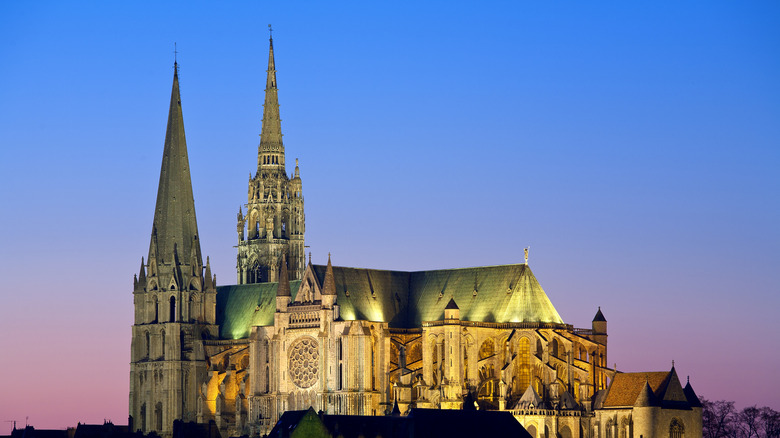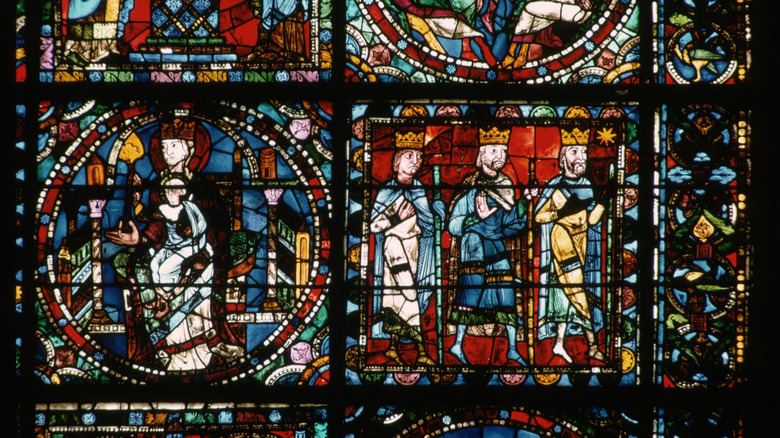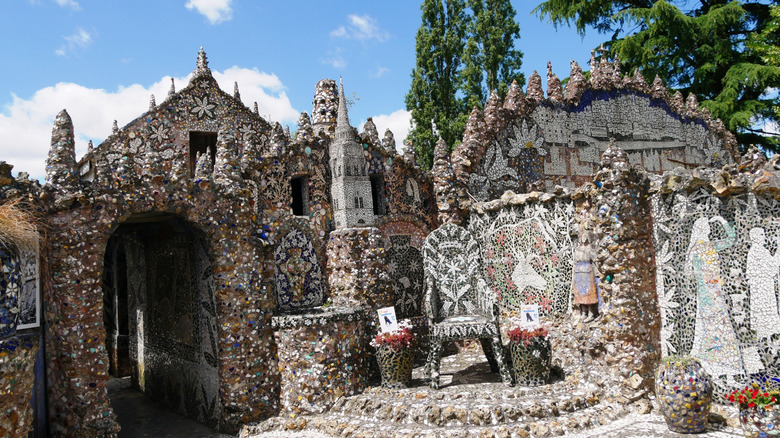Rick Steves Highlights This French Town For Its Relaxed Atmosphere And Architectural Masterpiece
Just a short hop from Paris by train, the charming medieval town of Chartres' walkable cobblestone streets invite you to become a "flâneur," the French term for one who wanders a city aimlessly, drinking in the sights, sounds and atmosphere with existential passion. Think of the term "tourist" without any of the negative connotations, the kind of thoughtful travel Rick Steves gently exhorts you to engage in. This town is a favorite of the TV host and guidebook author, an ancient place steeped in history, from marauding Vikings to Romans to visionary Catholic builders who manifested the stunning Gothic cathedral that dominates the townscape.
A cathedral of some kind has stood on this site since Roman times, and it became a pilgrimage site in 876 A.D., when it acquired a sacred relic, believed to be a shard of the Virgin Mary's Veil. In 1194, visionary Bishop Renaud de Mousson built the current Gothic masterpiece after the previous structure was decimated by fire, and it remains one of the most complete examples of the style anywhere in the world. It was also one of the very first UNESCO World Heritage Sites.
Rick Steves sums up the power of visiting a site where so much history is concentrated in a building that represents an apex of human achievement in artistry and ambition that has been equalled since, but perhaps never exceeded. "A few years ago, I had some quality time all alone at dusk with Chartres' Gothic statues," Steves writes on his blog. "The setting sun brought life to the expressions on their delicately carved faces. As I stood there, quiet and unrushed, it almost felt as though they were struggling to share with me the stories they've told eight centuries of pilgrims."
Chartres Cathedral was a modern marvel of its time
In the 11th century, there was no mainstream media. Books were still handwritten and kept largely in monasteries. The cathedral's stained glass and statuary were designed to illustrate the story of Christianity in a series of dramatic pictographs. Stained glass was a revelatory, magical storytelling tool of the Gothic era. The new architectural style using soaring flying buttresses to support more delicate, perforated wall structures allowed for expanses of glass for the first time.
Imagine for a moment that you're a medieval peasant walking into the kaleidoscopic nave of the grand cathedral in 1260 when it was first consecrated, to see a narrative unfold over 150 glowing, backlit panels of glass. The storytelling takes strategic advantage of the way light travels through the sky, with the Old Testament depicted on the shady side of the cathedral, and the dazzling events of the Christian era bathed in the full glory of the sun for maximum wow factor. The story even includes depictions of the skilled laborers like stonecutters, masons, carpenters, and glass artisans who built the cathedral over the course of 26 years, considered a very short project schedule at the time, as monumental historic structures could take hundreds of years to build.
Rick Steves highly recommends a tour by local legend Malcolm Miller of the American Friends of Chartres, a distinguished scholar who has been making Chartres come alive for visitors for upwards of 60 years (or his protégé Anne Marie Woods). "The Malcolm Miller Tour is essential and totally worth it," one Tripadvisor visitor writes. "He is brilliant and full of personality and humor, so that the tour is not some dry lecture. In fact, you could take the tour several times and he would not repeat himself."
More to see and do in and around Chartres
Although Chartres is a popular day trip from Paris, as it's only a 1.5-hour train ride away from the City of Light, you'll be missing one of the most enchanting experiences in this city that has its own light to shine, too, unless you opt to spend the night. Another top Rick Steves pick is Chartres in Lights, a city-wide sound and light show in which the cathedral's facade and other historic buildings and bridges around town are spectacularly illuminated as you traipse between them in an immersive experience.
Stay at the cathedral-adjacent Grand Monarque, then take Malcolm Miller's morning tour, have lunch at the Michelin-starred Le Georges back at your hotel, and rejoin Miller for the afternoon for another round of exciting cathedral lore, then bathe in light by night. On day two, you should pop by the quirky, enchanting La Maison Picassiette, a private home that one obsessed artisan, Raymond Isadiore, turned into a breathtaking and deeply personal museum starting in the 1930s by slathering every surface, from the furniture inside to the exterior outbuildings, with elaborate mosaic tile work. "The best thing we did during our 10 days in Chartres," writes one Tripadvisor fan. In a place with one of the most famous cathedrals in the world, that's saying a lot.
Another good reason to stay overnight is to linger among the Loire Valley's wineries and castles for a day or two before returning to Paris. See the Chateau du Chambord, the palace that inspired Disney's Imagineers to draw Beauty and the Beast, and become a flâneur all over again, stopping for a meal and a bottle of wine in the quaint Medieval town of Amboise.


